Latest Composite Price Indices Maintained Growth Streak Through the End of the Decade But Slowing Momentum Evident As Cycle Matures
CCRSI RELEASE – January 2020
(With data through December 2019)
Print Release (PDF)
Complete CCRSI data set accompanying this release
This month's CoStar Commercial Repeat Sale Indices (CCRSI) provides the market's first look at commercial real estate pricing trends through December 2019. Based on 1,522 repeat sale pairs in December 2019 and more than 221,567 repeat sales since 1996, the CCRSI offers the broadest measure of commercial real estate repeat sales activity.
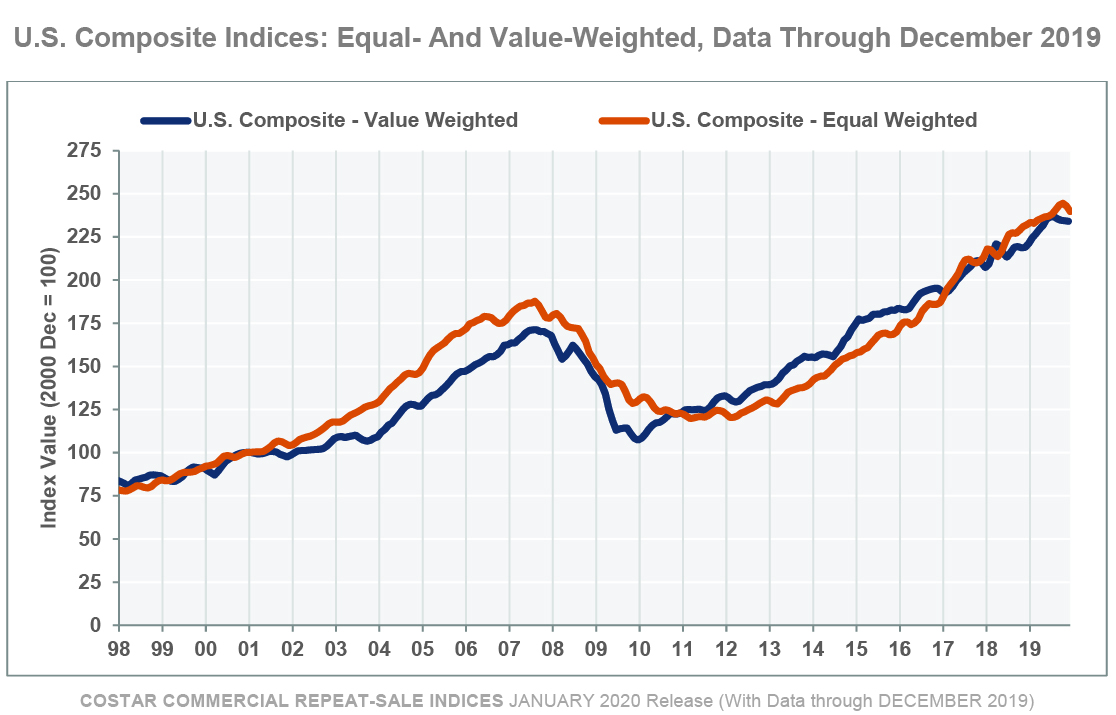
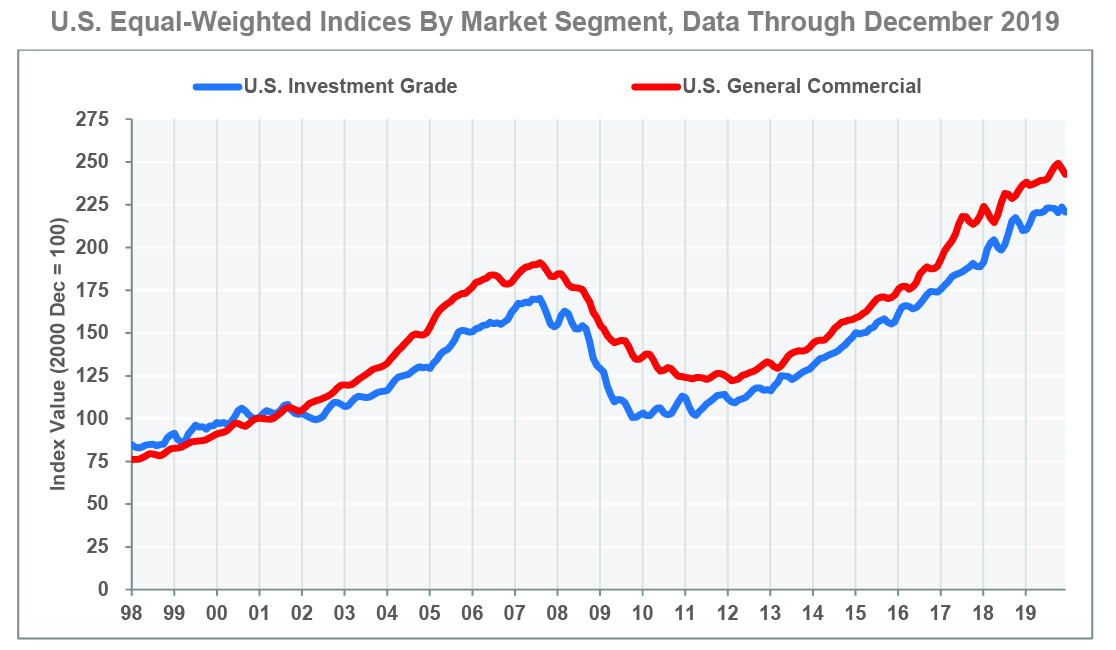
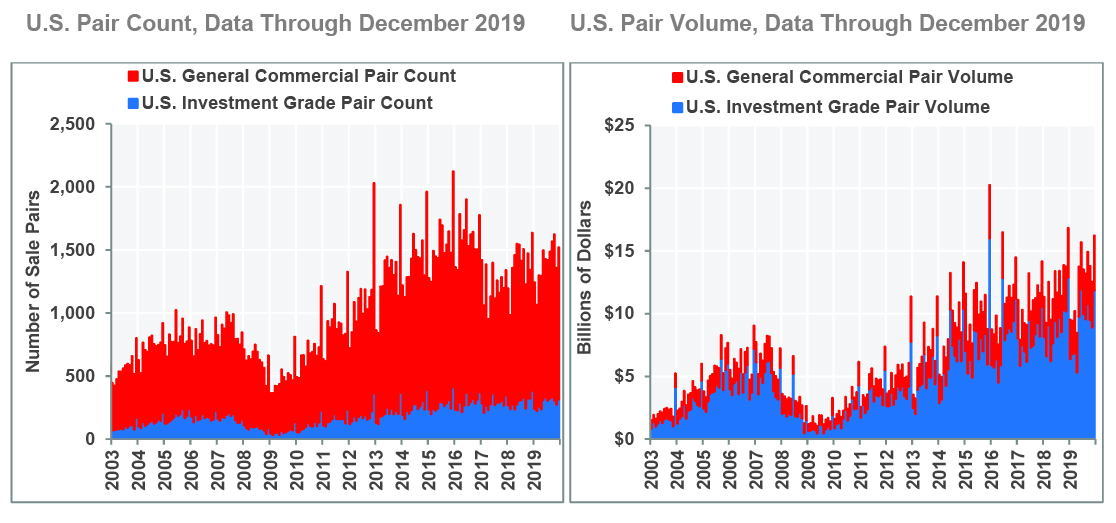
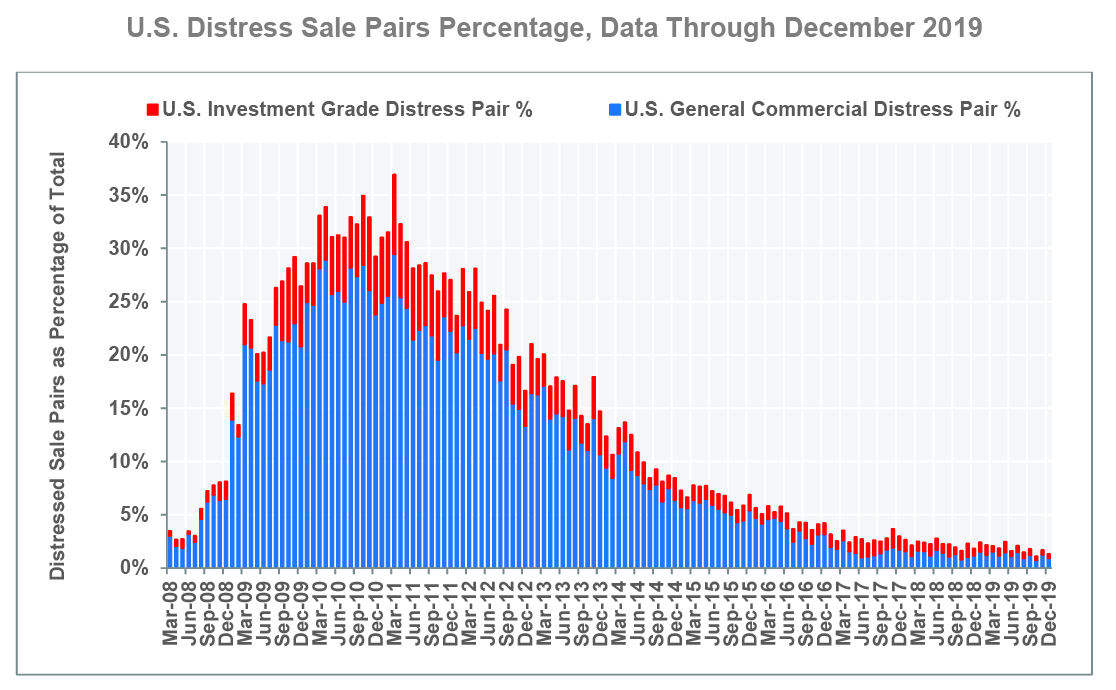
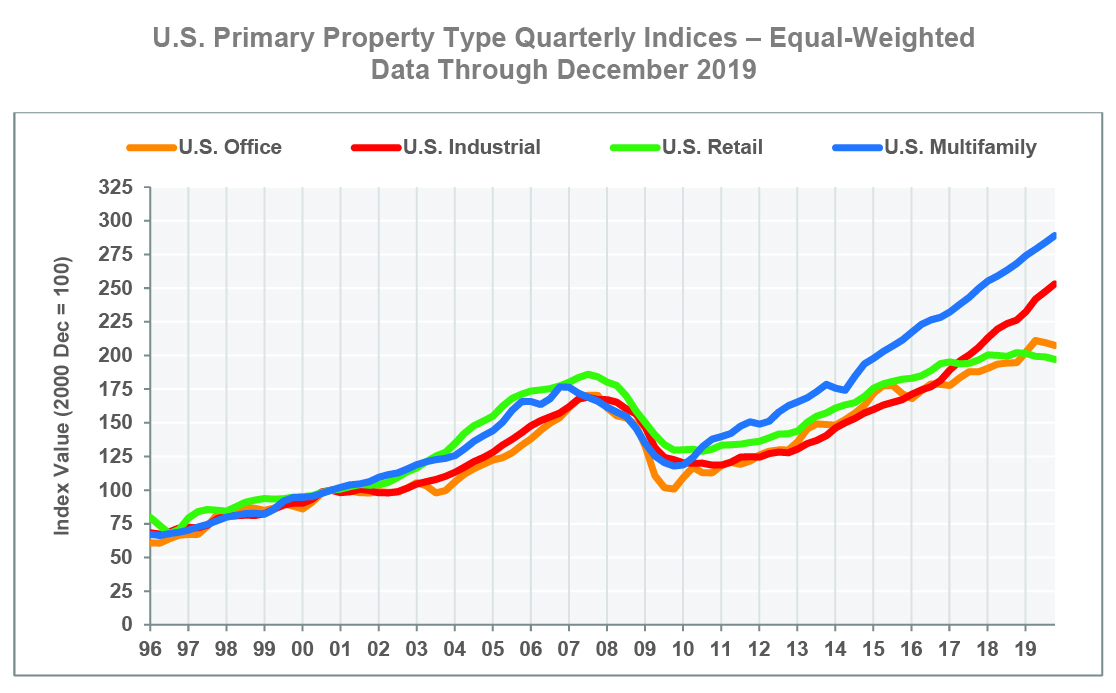
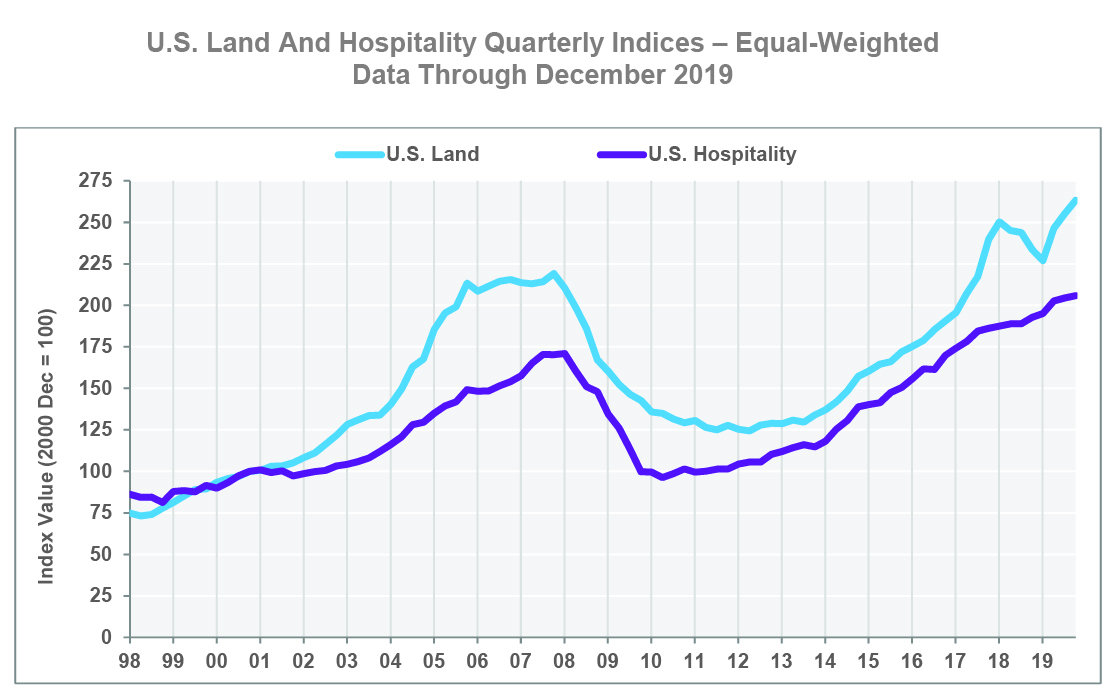
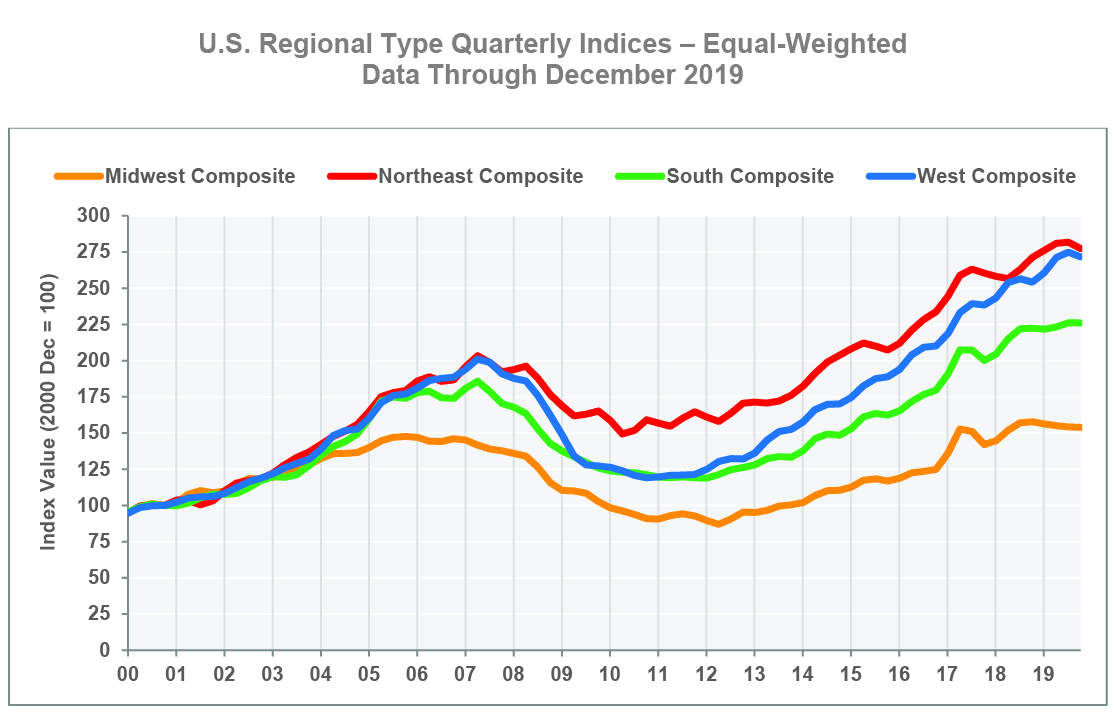

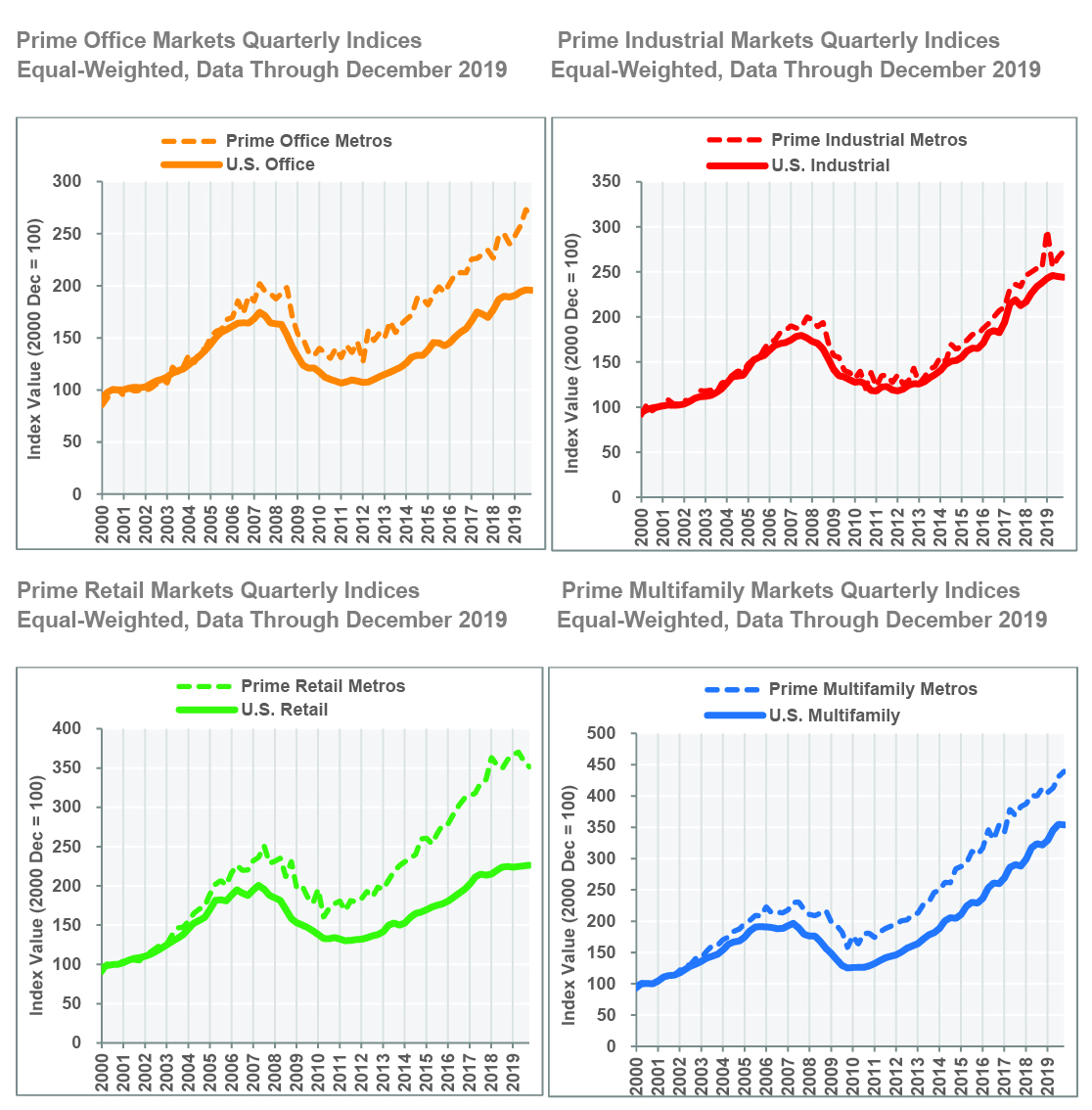
CCRSI National Results Highlights
-
PRICE GROWTH WAS RESILIENT IN 2019, supported by a broad base of positive trends. Most major property types continued to benefit from manageable speculative construction and rising rental rates, as the longest economic expansion on record continued to fuel demand. Meanwhile, benchmark interest rates such as the ten-year treasury remained low, a positive underlying trend for commercial real estate cap rates. The two broadest measures of aggregate pricing for commercial properties within the CCRSI — the value-weighted U.S. Composite Index and the equal-weighted U.S. Composite Index — increased by 7% and 3.5%, respectively, in 2019.
-
HOWEVER, SLOWER PRICE GROWTH IS EVIDENT, AS THE CYCLE HAS MATURED. The single-digit gains in both composite price indices in 2019 generally marked a deceleration from double-digit gains reached in the middle of the last decade. However, in 2019, both composite indices were more than 30% above previous peak levels reached before the last recession, reflecting strong investor interest and outperformance this cycle.
-
MULTIFAMILY LED GROWTH AMONG MAJOR PROPERTY-TYPE INDICES IN 2019. Sturdy market fundamentals supported continued price growth across the property type spectrum in 2019, with the exception of retail. The Multifamily Index increased 8.8% in 2019, well above annual growth in the range of 2%-7% in the Industrial, Office, and Hotel indices. The Retail Index was flat in 2019 as e-commerce competition continued to provide headwinds to brick-and-mortar retail.
-
WEST REGION MAINTAINED STRONGEST GROWTH MOMENTUM AMONG THE FOUR REGIONS. The West Composite Index advanced 6.9% in 2019, the only region to see an acceleration in growth from 2018. Price gains in the Northeast have naturally slowed following an extended period of above average growth early in the cycle, while the Midwest continued to lag given its concentration of demographically mature, slow-growing markets.
-
OVERALL TRANSACTION VOLUME INCREASED MODESTLY IN 2019. Composite transaction volume reached $151.4 billion in 2019, up 2.1% from 2018. The lower end of the commercial property market had more momentum in terms of sales activity. Transaction volume rose 5.7% in the General Commercial segment, compared to 0.7% in the Investment-Grade segment, in 2019 compared to 2018.
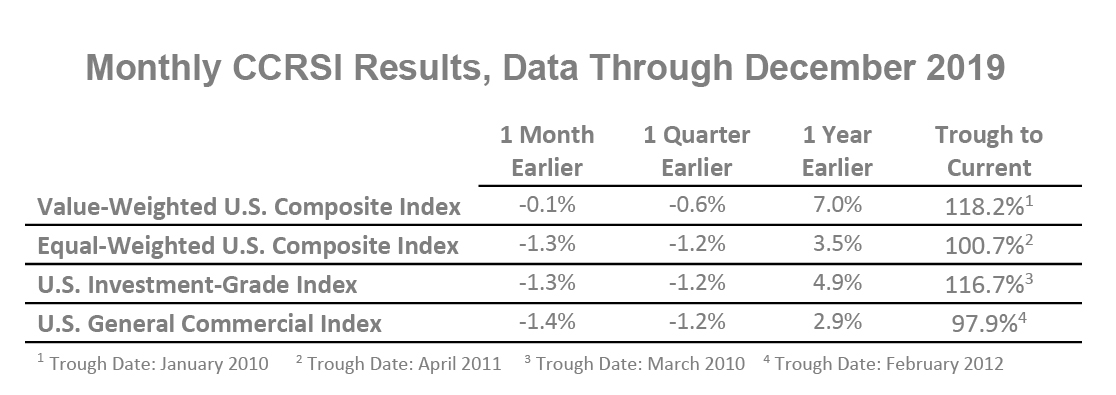
Quarterly CCRSI Property Type Results
-
GROWTH ACROSS THE FOUR MAJOR PROPERTY TYPES DECELERATED IN 2019. Following double-digit gains across most property sectors in 2018, growth slowed to the single-digits in 2019. The exception is the retail index, which was flat in 2019. The Prime Markets Indices within each property sector, which are dominated by the large, core, coastal metros, increased at varying rates in 2019. Pricing in prime metros in the office and industrial property types was stronger than in the broader market in 2019, while prices in prime multifamily markets grew more slowly than the broader market in 2019.
-
THE MULTIFAMILY INDEX WAS THE TOP PERFORMER AMONG THE FOUR MAJOR PROPERTY TYPES IN 2019. Despite high levels of new construction at the top of the market and already-high pricing, the U.S. Multifamily Index posted a gain of 8.8% in 2019, the strongest growth among the four major property types, although a slowdown from the double-digit growth rate the sector had maintained since 2011. The Prime Multifamily Metros Index increased 5.6% in 2019, a slower rate than the broader market, suggesting somewhat slower price growth in high-value properties in primary markets.
-
U.S. INDUSTRIAL INDEX INCREASED 2.3% IN 2019. The U.S. Industrial Index advanced 2.3% in 2019, below the double-digit annual pace set in 2016-2018. While some slowing in momentum was expected, the abruptness of the slowdown was somewhat surprising given the continued strength in market fundamentals as vacancies held below 5% and rent growth bested the other major property types in 2019. Given strong underlying market fundamentals, pricing in the Prime Industrial Metros Index grew at a brisk 6.7% rate in 2019.
-
U.S. OFFICE INDEX TURNED IN A SOLID PEFORMANCE IN 2019. The U.S. Office Index advanced 3.4% in 2019, reflecting continued, albeit modest, improvement in office rent levels and occupancy rates nationally. Price growth in core markets proved even more resilient, with the Prime Office Metros Index up by a stronger 9.3% in 2019.
-
RETAIL PRICES WERE FLAT IN 2019. After sustaining first-quarter declines, the U.S. Retail Index rebounded with modest growth in the fourth quarter of 2019. The net result was a 0% gain on annual basis and the weakest performance of the four major property type indices in 2019. The bifurcation in retail fundamentals performance translates to the investment market as well. Good quality, well-located retail continues to command investor interest and pricing growth, while pricing is regressing in centers with elevated vacancy rates. Still even in core markets, poorly located retail is suffering. The Prime Retail Metros Index declined 2.1% in 2019.
-
U.S. HOSPITALITY INDEX GROWTH REMAINED A BRIGHT SPOT. The U.S. Hospitality Index was up 0.7% in the fourth quarter, contributing to annual gains of 6.8% in 2019. Fundamentals remained in solid shape as national hotel occupancies remained near record high levels and RevPAR growth continued. The U.S. Hospitality Index ended 2019 more than 20% above its pre-recession peak.
-
THE VOLATILE U.S. LAND INDEX ENDED 2019 UP 12.7%. The U.S. Land Index is the most volatile of the property type indices. After falling in most of 2018 and the first quarter of 2019, the Land Index jumped over the last three quarters, ending 2019 up 12.7% on the strength of continued demand for development sites.
Quarterly CCRSI Regional Results
-
BROAD-BASED GROWTH ACROSS THE PROPERTY TYPES BOLSTERED WEST REGIONAL INDEX. The concentration of high-growth, tech-focused markets that have led demand growth this cycle bolstered performance in the West region. The West Composite Index advanced 6.9% in 2019 besting annual growth in the other regions by several percentage points. The West Multifamily Index was the standout performer, increasing 11.4% in 2019, the only regional property-type index to reach double-digit growth in the last year. The West Industrial and Office Indices each increased by around 5%, while the West Retail Index was the slowest growing in the region but still advanced 2.8% in 2019.
-
A HIGH CONCENTRATION OF FASTER GROWING SUNBELT MARKETS HAS LIFTED GROWTH IN THE SOUTH REGION. The South region exhibited a moderate gain of 1.7% in 2019, led by above average growth of 8.1% in the South Multifamily Index and 3.1% in the South Office Index. The retail sector exhibited weakness in 2019, falling by 1.5%, which follows the national trend.
-
MULTIFAMILY, RETAIL, SHOW STRONGEST GROWTH IN NORTHEAST. The Northeast Composite Index advanced 2.2% in 2019, driven in large part by strong growth in the Northeast Multifamily Index. The Northeast Multifamily Index was up 3.2% in 2019, the fifth strongest annual growth rate among the 16 regional property type indices. Meanwhile, the Northeast Retail Index continued to inch up, with growth of 0.3% in 2019, the only regional retail index to show growth in 2019 outside of the West region.
-
WEAKNESS IN THE RETAIL AND INDUSTRIAL SEGMENTS DROVE DECLINES IN THE MIDWEST REGIONAL INDEX. The Midwest Composite index fell 2.5% in 2019, dragged down by losses the Midwest Retail and Industrial indices. The concentration of slow-growing demographically mature markets in the Midwest have led to slower improvements in market fundamentals and weaker investor interest this cycle.
About The CoStar Commercial Repeat-Sale Indices
The CoStar Commercial Repeat-Sale Indices (CCRSI) is the most comprehensive and accurate measure of commercial real estate prices in the United States. In addition to the national Composite Index (presented in both equal-weighted and value-weighted versions), national Investment-Grade Index, and national General Commercial Index, which we report monthly, we report quarterly on 30 sub-indices in the CoStar index family. The sub-indices include breakdowns by property sector (office, industrial, retail, multifamily, hospitality, and land), by region of the country (Northeast, South, Midwest, and West), by transaction size and quality (general commercial, investment-grade), and by market size (composite index of the prime market areas in the country).
The CoStar indices are constructed using a repeat sales methodology, widely considered the most accurate measure of price changes for real estate. This methodology measures the movement in the prices of commercial properties by collecting data on actual transaction prices. When a property is sold more than once, a sales pair is created. The prices from the first and second sales are then used to calculate price movement for the property. The aggregated price changes from all of the sales pairs are used to create a price index.
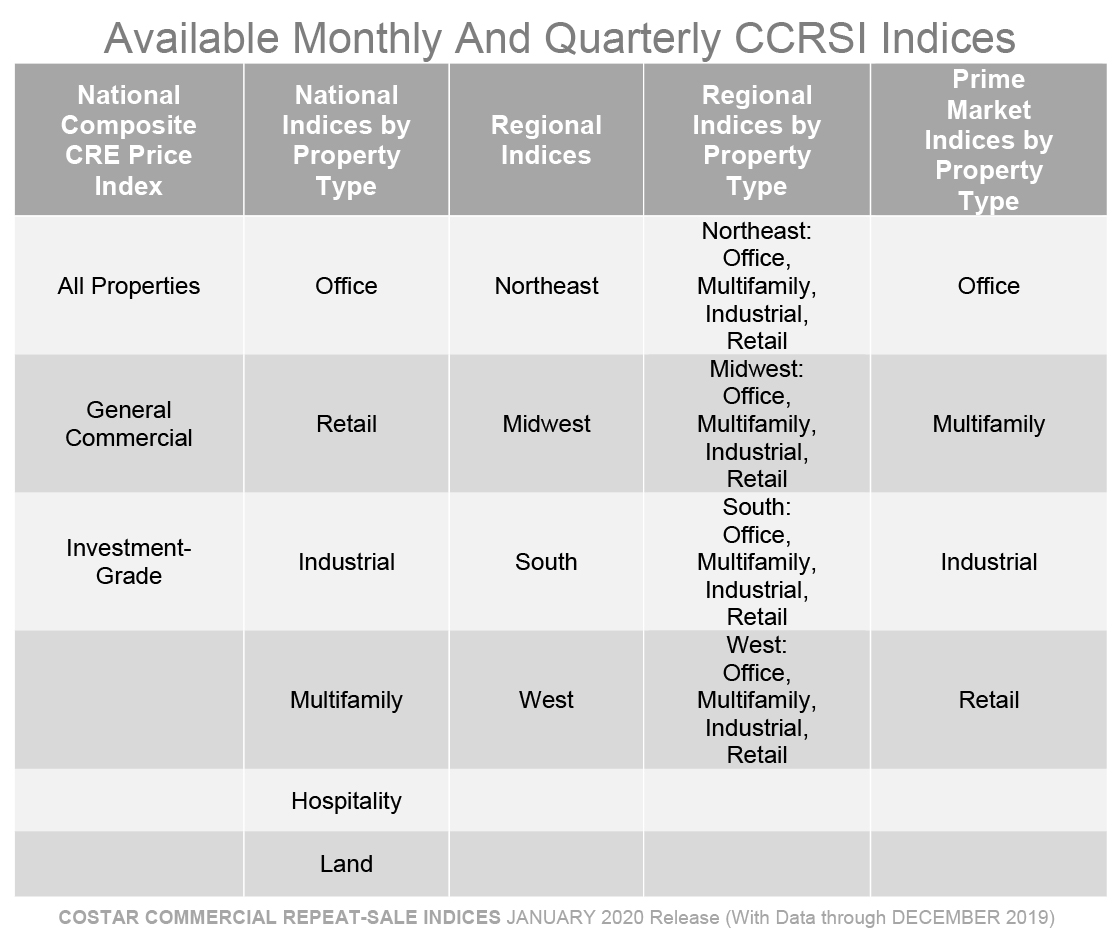
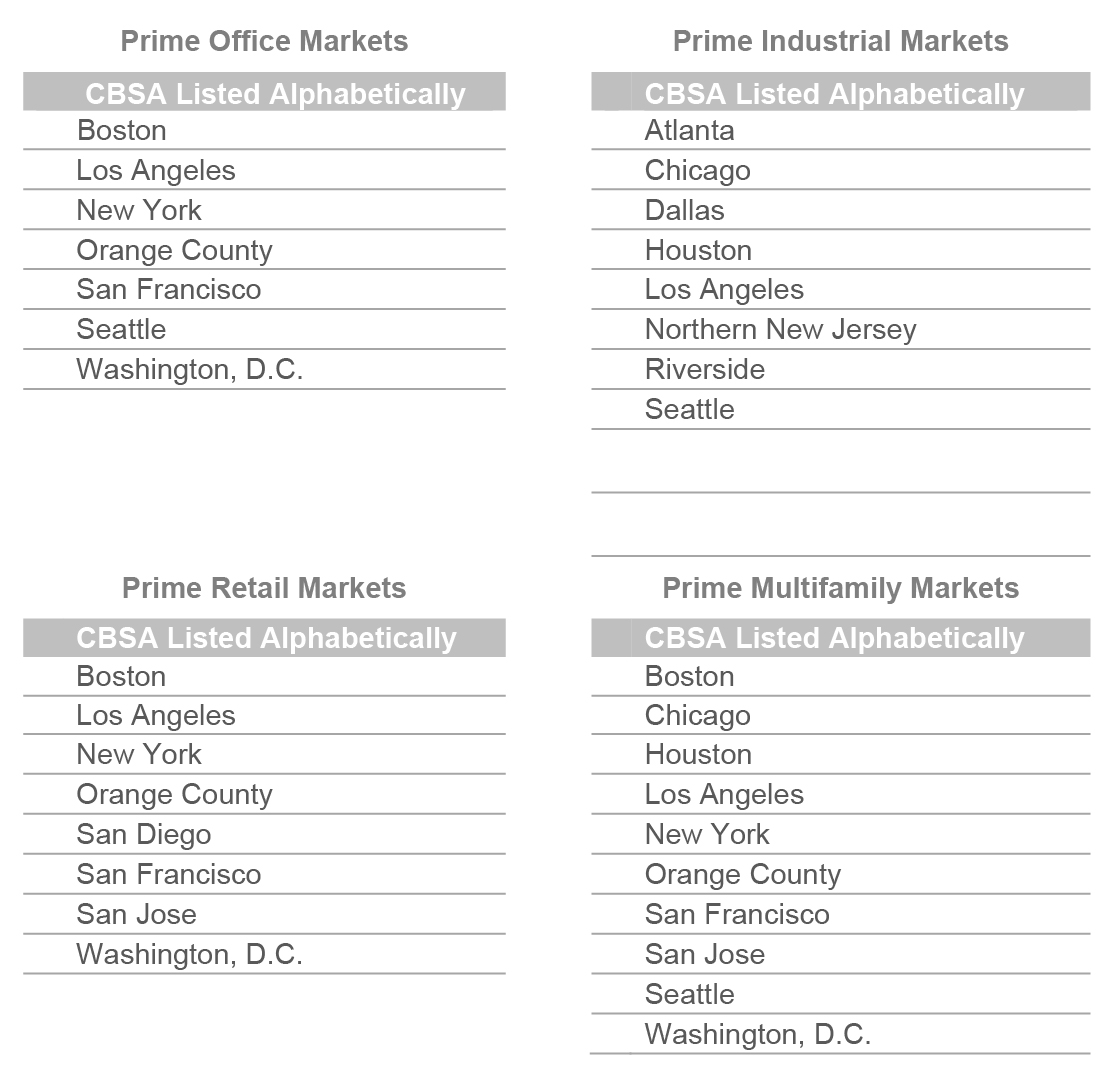
Media Contact:
Kendall Ridley, Senior Manager, External Communications, CoStar Group kridley@costar.com.
For more information about the CCRSI Indices, including the full accompanying data set and research methodology, legal notices and disclaimer, please visit https://costargroup.com/costar-news/ccrsi.
ABOUT COSTAR GROUP, INC.
CoStar Group, Inc. (NASDAQ: CSGP) is the leading provider of commercial real estate information, analytics and online marketplaces. Founded in 1987, CoStar conducts expansive, ongoing research to produce and maintain the largest and most comprehensive database of commercial real estate information. Our suite of online services enables clients to analyze, interpret and gain unmatched insight on commercial property values, market conditions and current availabilities. STR provides premium data benchmarking, analytics and marketplace insights for the global hospitality sector. LoopNet is the most heavily trafficked commercial real estate marketplace online with over 6 million monthly unique visitors. Realla is the UK’s most comprehensive commercial property digital marketplace. Apartments.com, ApartmentFinder.com, ForRent.com, ApartmentHomeLiving.com, WestsideRentals.com, AFTER55.com, CorporateHousing.com, ForRentUniversity.com and Apartamentos.com form the premier online apartment resource for renters seeking great apartment homes and provide property managers and owners a proven platform for marketing their properties. CoStar Group’s websites attracted an average of over 51 million unique monthly visitors in aggregate in the third quarter of 2019. Headquartered in Washington, DC, CoStar maintains offices throughout the U.S. and in Europe and Canada with a staff of over 4,300 worldwide, including the industry’s largest professional research organization. For more information, visit www.costargroup.com.

